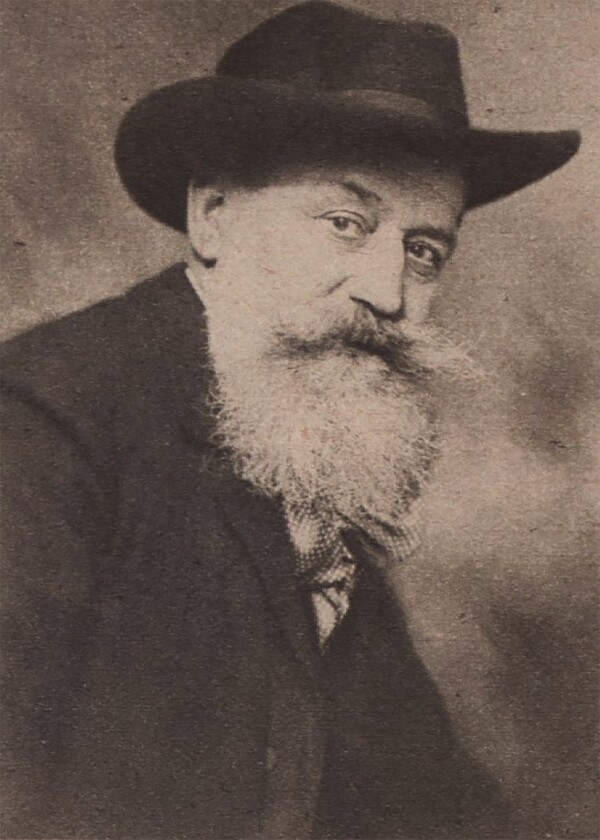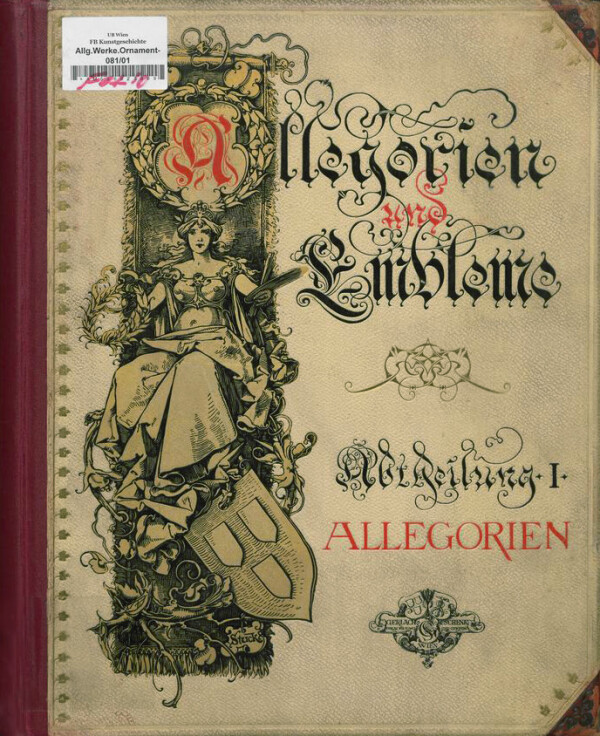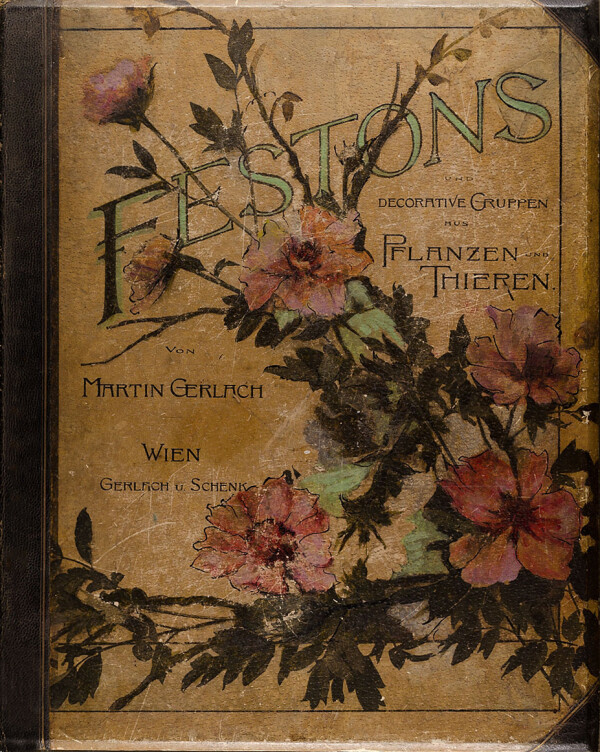Martin Gerlach

Martin Gerlach photographed by Hermann Clemens Kosel, around 1905, in: Das interessante Blatt, 16.03.1916.
© Klimt Foundation, Vienna

Martin Gerlach (Hg.): Allegorien und Embleme. Originalentwürfe von den hervorragendsten modernen Künstlern, sowie Nachbildungen alter Zunftzeichen und modernen Entwürfen von Zunftwappen im Charakter der Renaissance. Abtheilung I. Allegorien, Vienna 1882/84.
© University of Vienna, Departmental Library of Art History

Martin Gerlach: Festons, Vienna 1897, Museum für Kunst und Gewerbe Hamburg (MK&G)
© Museum für Kunst und Gewerbe Hamburg
The German-Austrian draftsman, photographer and publisher Martin Gerlach published several designs by Gustav Klimt in his portfolio Allegorien und Embleme. His publishing company also collaborated closely with the Secession.
Martin Gerlach was born as the son of Georg and Katharina Gerlach, née Schwarz, in Hannau, Hesse, on 13 March 1846. He attended the local graphic art academy and trained as a chaser and engraver for six years. Together with A. Schwarz, he founded a large gold and jewelry store in Berlin in 1868. The store was liquidated in 1870. In 1873, Gerlach got engaged to Marie Meinel, whom he married soon after. Gerlach then opened a publishing house in Berlin, specializing in artistic books on architecture, ornamentation and botany. His first publication was the award-winning collection of designs Die Perle [The Pearl], for which Gerlach himself created designs and sample drawings for the section on the goldsmith and jewelry industry.
Gerlach and his publishing company moved to Vienna in 1874. Together with Ferdinand Schenk, he founded the Polygraphic Art Institute and the art publishing house Martin Gerlach & Comp., which was renamed Gerlach & Schenk, Verlag für Kunst und Gewerbe in 1882.
Following the success of Die Perle, Gerlach focused on the creation of collections of designs for visual artists and artisans. He published the successful portfolio Allegorien und Embleme [Allegories and Emblems] (1882–1885; Neue Folge [New Series], around 1900) with original designs of allegorical figures and decorative ornaments by modern, contemporary artists. In addition to renowned painters such as Franz von Stuck, Gerlach also gave the young and as yet little known artists Gustav and Ernst Klimt as well as Franz Matsch the opportunity to contribute to the portfolio.
While the first volume was still in keeping with the academic tastes of Historicism, Kolo Moser, Carl Otto Czeschka and Gustav Klimt created allegories in modern Jugendstil for the second volume Neue Folge.
Kolo Moser recalls that Klimt met with Gerlach personally in 1896 to present his design Sculpture (1896, Wien Museum) for Allegorien Neue Folge No. 58 and to discuss its execution. It seems that Klimt and Gerlach collaborated closely on Allegorien und Embleme. It is therefore not surprising that Gerlach & Schenk were put in charge of printing the Secession’s magazine Ver Sacrum in 1898.
The publishing company also distributed many other reference works, including Blumen und Pflanzen zur Verwendung für kunstgewerbliche Decorationsmotive und den Zeichenunterricht [Flowers and Plants to Be Used as Artistic Decorations and for Drawing Lessons] (1892) as well as the arts and crafts anthology Die Quelle [The Source].
After Gerlach had become a member of the Photographic Society in Vienna in 1895, he traveled through the Monarchy and Bavaria for his photographic studies. He was especially interested in capturing folkloric motifs. He used these clichés for many of his publications, such as the Jubiläumsausgabe des Albums der Stadt Wien [Souvenir Album of the City of Vienna, Anniversary Edition] and Die Wachau in Wort und Bild [The Wachau Region in Texts and Images]. The art critic Joseph August Lux called Gerlach a “leader of Modernism” in the field of photography.
The publishing house once more changed its name to Martin Gerlach & Co., Buch- und Kunstverlag in 1901, after Albert Wiedling had taken Schenk’s place. In 1907, Gerlach was appointed an Imperial Councilor in recognition of his work. He was knighted in 1913, becoming a member of the Order of Franz Joseph.
The repertoire of the publishing company was expanded after the turn of the century. In addition to art-related works, it now also published several literary series, such as Gerlachs Jugendbücherei [Gerlach’s Library for Young Readers] and Meisterwerke deutscher Prosa [Masterpieces of German Prose]. Jugendstil artists from Austria and abroad were commissioned to create the illustrations, including Ferdinand Staeger, Ignatius Taschner, Bertold Löffler, Ferdinand Andri and Carl Otto Czeschka. Gerlach furthermore published several works on Vienna’s history and topography, such as Max Eisler’s 1919 publication Historischer Atlas des Wiener Stadtbildes [Historic Atlas of the City of Vienna].
Martin Gerlach died on 9 April 1918, the same year as Gustav Klimt and Egon Schiele. His son Franz took over the company together with Walter Wiedling, the son of Gerlach’s business partner. Gerlach’s second son Martin Gerlach jun. became a photographer and for instance photographed Serena Lederer and Friederike Maria Beer, who had been portrayed by Klimt.
Literature and sources
- Wien Geschichte Wiki. Martin Gerlach. www.geschichtewiki.wien.gv.at/Gerlach_%26_Wiedling (04/16/2020).
- Astrid Mahler, Elborg Forster: A World of Forms from Nature. New Impulses for the Aesthetic of the Jugendstil (04.01.2011). www.tandfonline.com/doi/abs/10.1080/01973760701219339 (04/16/2020).
- Buchdrucker-Zeitung, 05.01.1883, S. 4.
- Österreichische Illustrierte Zeitung, 21.04.1918, S. 512.
- W.: Zum 70. Geburtstage Martin Gerlachs, in: Reichspost, 11.03.1916, S. 3.
- Karl Moser: Begegnung mit Gustav Klimt, Nach Aufzeichnungen des Malers Koloman Moser, in: Neues Wiener Journal, 01.03.1931, S. 22-23.
- Börsenblatt für den deutschen Buchhandel. Fachzeitschr. für Verlagswesen u. Buchhandel, 13.05.1872, S. 8.
- Berliner Börsen-Zeitung, 09.04.1873, S. 14.
- Murray G. Hall: Österreichische Verlagsgeschichte. Band I. Entwicklung des Verlagsbuchhandels in Österreich bis 1918. verlagsgeschichte.murrayhall.com/ (05/18/2020).
- Notizen von Kolo Moser betreffend Klimts Zeichnung »Sculptur« für das Mappenwerk »Allegorien und Embleme. Neue Folge« (undatiert). H.I.N. 160.514, .

